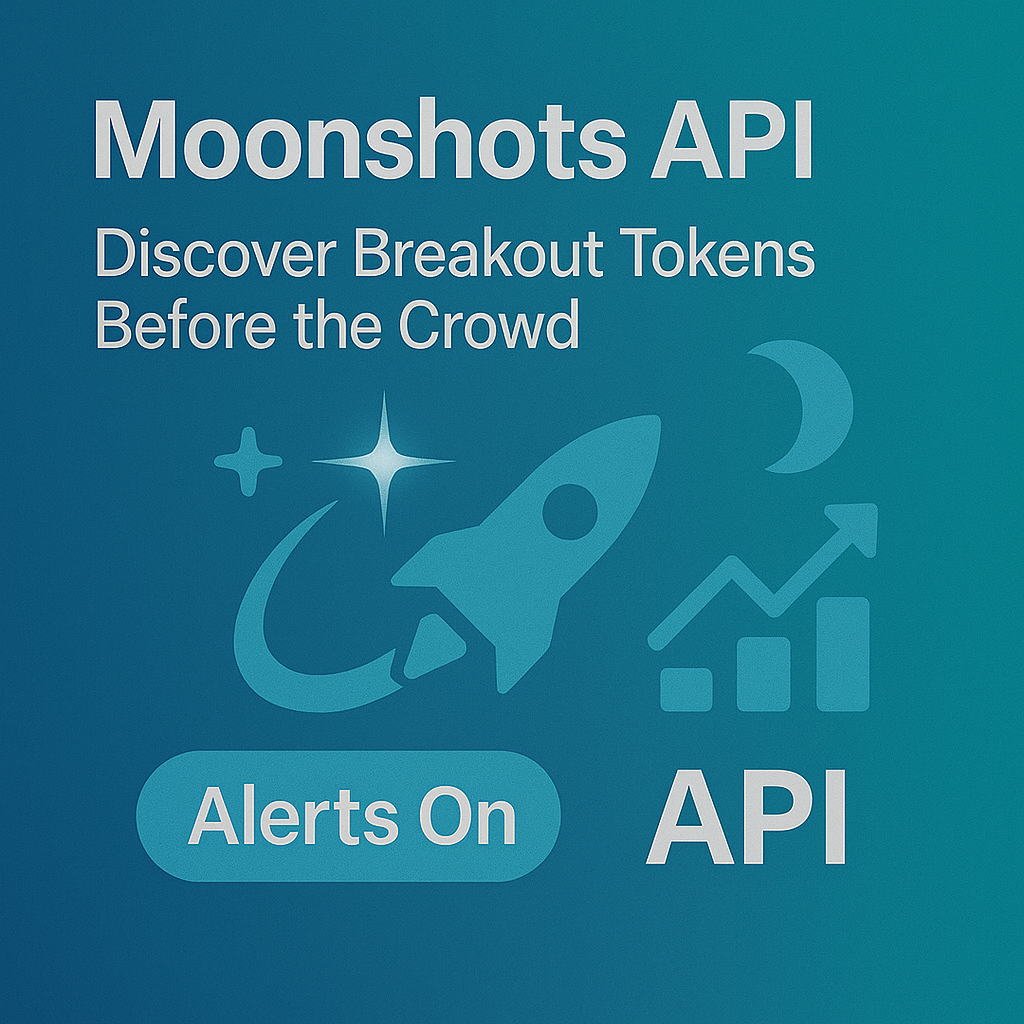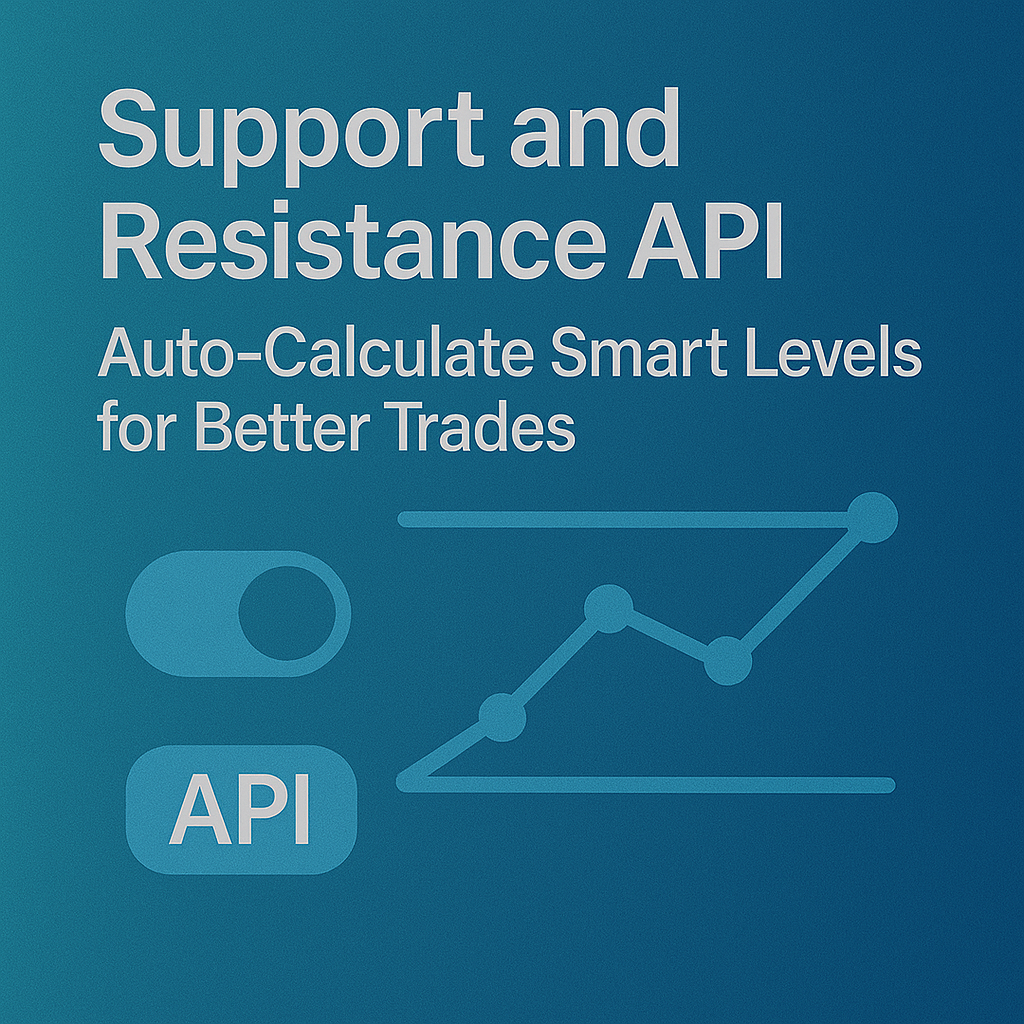Top Crypto Trading Platforms in 2025







%201.svg)
%201.svg)
Big news: We’re cranking up the heat on AI-driven crypto analytics with the launch of the Token Metrics API and our official SDK (Software Development Kit). This isn’t just an upgrade – it's a quantum leap, giving traders, hedge funds, developers, and institutions direct access to cutting-edge market intelligence, trading signals, and predictive analytics.
Crypto markets move fast, and having real-time, AI-powered insights can be the difference between catching the next big trend or getting left behind. Until now, traders and quants have been wrestling with scattered data, delayed reporting, and a lack of truly predictive analytics. Not anymore.
The Token Metrics API delivers 32+ high-performance endpoints packed with powerful AI-driven insights right into your lap, including:
Getting started with the Token Metrics API is simple:
At Token Metrics, we believe data should be decentralized, predictive, and actionable.
The Token Metrics API & SDK bring next-gen AI-powered crypto intelligence to anyone looking to trade smarter, build better, and stay ahead of the curve. With our official SDK, developers can plug these insights into their own trading bots, dashboards, and research tools – no need to reinvent the wheel.
%201.svg)
%201.svg)
The biggest gains in crypto rarely come from the majors. They come from Moonshots—fast-moving tokens with breakout potential. The Moonshots API surfaces these candidates programmatically so you can rank, alert, and act inside your product. In this guide, you’ll call /v2/moonshots, display a high-signal list with TM Grade and Bullish tags, and wire it into bots, dashboards, or screeners in minutes. Start by grabbing your key at Get API Key, then Run Hello-TM and Clone a Template to ship fast.
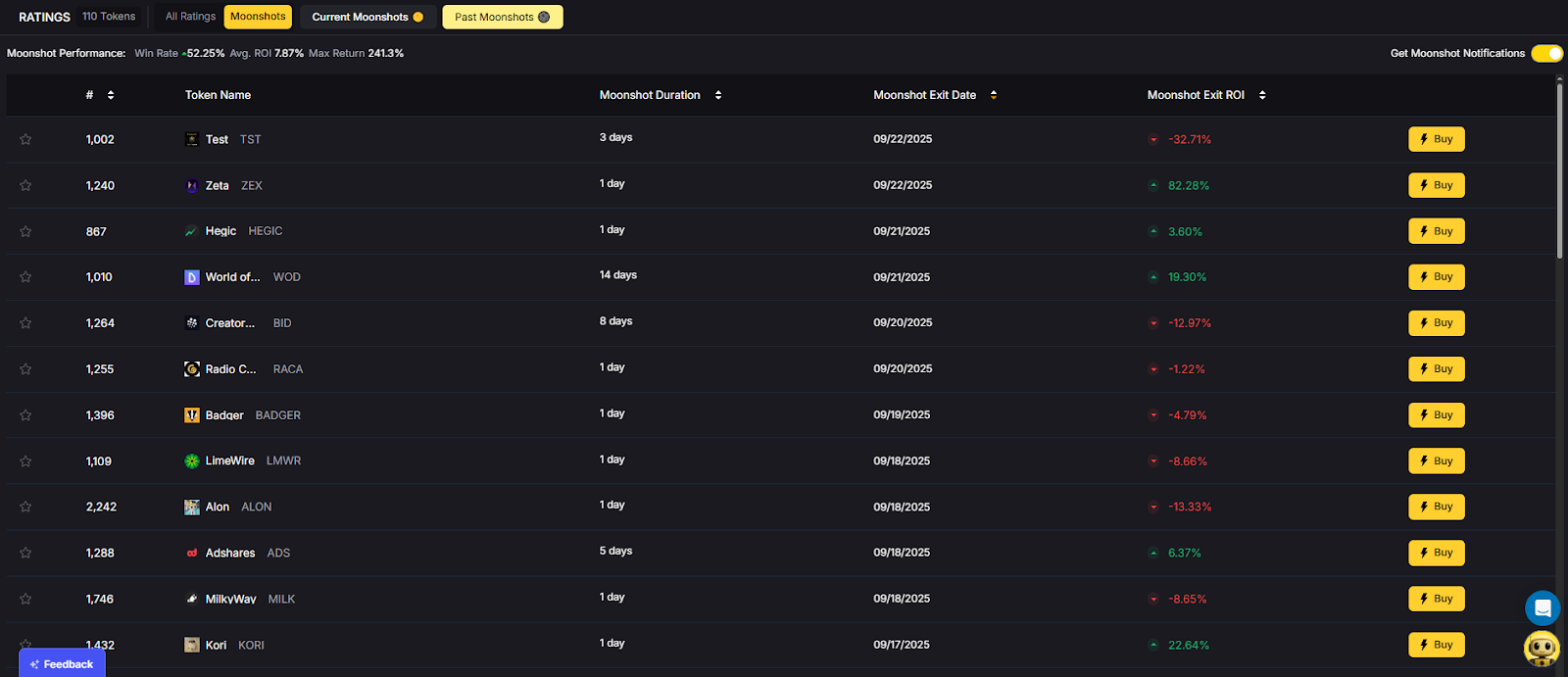
Discovery that converts. Users want more than price tickers—they want a curated, explainable list of high-potential tokens. The moonshots API encapsulates multiple signals into a short list designed for exploration, alerts, and watchlists you can monetize.
Built for builders. The endpoint returns a consistent schema with grade, signal, and context so you can immediately sort, badge, and trigger workflows. With predictable latency and clear filters, you can scale to dashboards, mobile apps, and headless bots without reinventing the discovery pipeline.
The Moonshots API cURL request is right there in the top right of the API Reference. Grab it and start tapping into the potential!
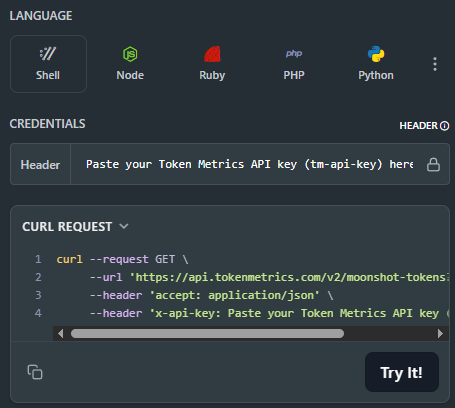
👉 Keep momentum: Get API Key • Run Hello-TM • Clone a Template
Fork a screener or alerting template, plug your key, and deploy. Validate your environment with Hello-TM. When you scale users or need higher limits, compare API plans.
The Moonshots endpoint aggregates a set of evidence—often combining TM Grade, signal state, and momentum/volume context—into a shortlist of breakout candidates. Each row includes a symbol, grade, signal, and timestamp, plus optional reason tags for transparency.
For UX, a common pattern is: headline list → token detail where you render TM Grade (quality), Trading Signals (timing), Support/Resistance (risk placement), Quantmetrics (risk-adjusted performance), and Price Prediction scenarios. This lets users understand why a token was flagged and how to act with risk controls.
Polling vs webhooks. Dashboards typically poll with short-TTL caching. Alerting flows use scheduled jobs or webhooks (where available) to smooth traffic and avoid duplicates. Always make notifications idempotent.
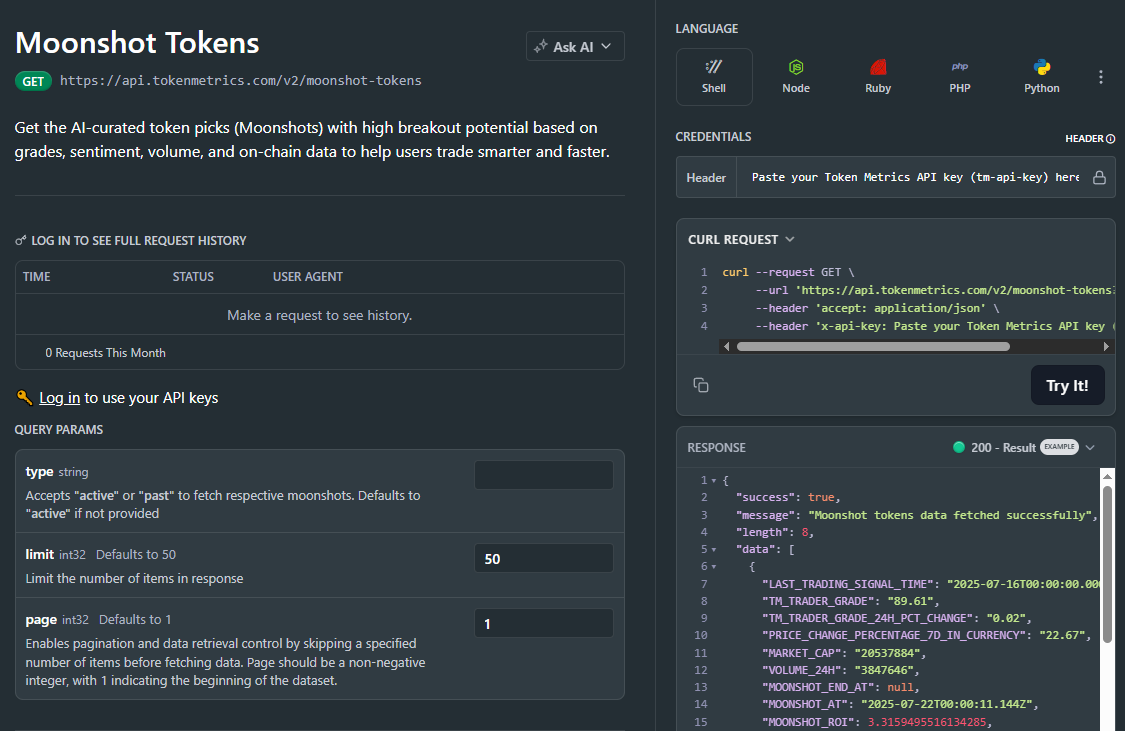
1) What does the Moonshots API return?
A list of breakout candidates with fields such as symbol, tm_grade, signal (often Bullish/Bearish), optional reason tags, and updated_at. Use it to drive discover tabs, alerts, and watchlists.
2) How fresh is the list? What about latency/SLOs?
The endpoint targets predictable latency and timely updates for dashboards and alerts. Use short-TTL caching and queued jobs/webhooks to avoid bursty polling.
3) How do I use Moonshots in a trading workflow?
Common stack: Moonshots for discovery, Trading Signals for timing, Support/Resistance for SL/TP, Quantmetrics for sizing, and Price Prediction for scenario context. Always backtest and paper-trade first.
4) I saw results like “+241%” and a “7.5% average return.” Are these guaranteed?
No. Any historical results are illustrative and not guarantees of future performance. Markets are risky; use risk management and testing.
5) Can I filter the Moonshots list?
Yes—pass parameters like min_grade, signal, and limit (as supported) to tailor to your audience and keep pages fast.
6) Do you provide SDKs or examples?
REST works with JavaScript and Python snippets above. Docs include quickstarts, Postman collections, and templates—start with Run Hello-TM.
7) Pricing, limits, and enterprise SLAs?
Begin free and scale up. See API plans for rate limits and enterprise options.
%201.svg)
%201.svg)
Most traders still draw lines by hand in TradingView. The support and resistance API from Token Metrics auto-calculates clean support and resistance levels from one request, so your dashboard, bot, or alerts can react instantly. In minutes, you’ll call /v2/resistance-support, render actionable levels for any token, and wire them into stops, targets, or notifications. Start by grabbing your key on Get API Key, then Run Hello-TM and Clone a Template to ship a production-ready feature fast.
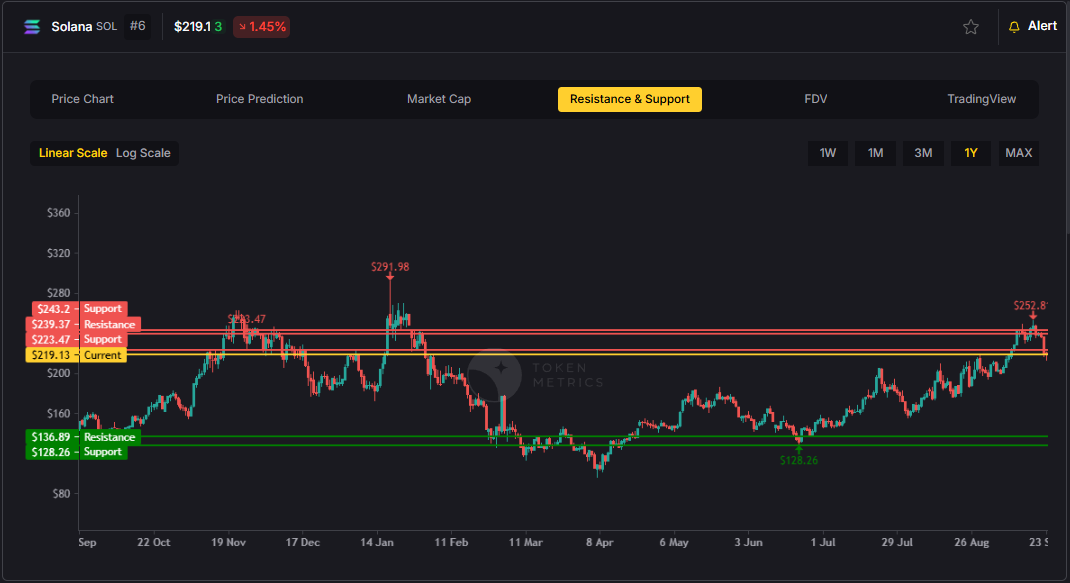
Precision beats guesswork. Hand-drawn lines are subjective and slow. The support and resistance API standardizes levels across assets and timeframes, enabling deterministic stops and take-profits your users (and bots) can trust.
Production-ready by design. A simple REST shape, predictable latency, and clear semantics let you add levels to token pages, automate SL/TP alerts, and build rule-based execution with minimal glue code.
Need the Support and Resistance data? The cURL request for it is in the top right of the API Reference for quick access.
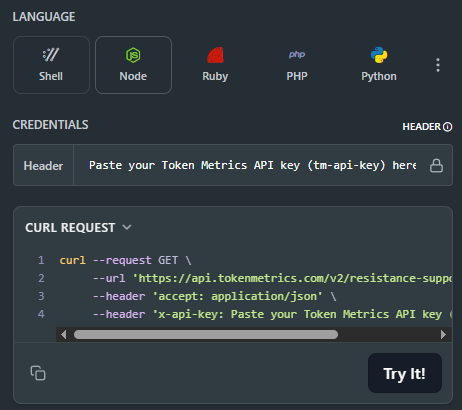
👉 Keep momentum: Get API Key • Run Hello-TM • Clone a Template
Kick off with our quickstarts—fork a bot or dashboard template, plug your key, and deploy. Confirm your environment by Running Hello-TM. When you’re scaling or need webhooks/limits, review API plans.
The Support/Resistance endpoint analyzes recent price structure to produce discrete levels above and below current price, along with strength indicators you can use for priority and styling. Query /v2/resistance-support?symbol=<ASSET>&timeframe=<HORIZON> to receive arrays of level objects and timestamps.
Polling vs webhooks. For dashboards, short-TTL caching and batched fetches keep pages snappy. For bots and alerts, use queued jobs or webhooks (where applicable) to avoid noisy, bursty polling—especially around market opens and major events.
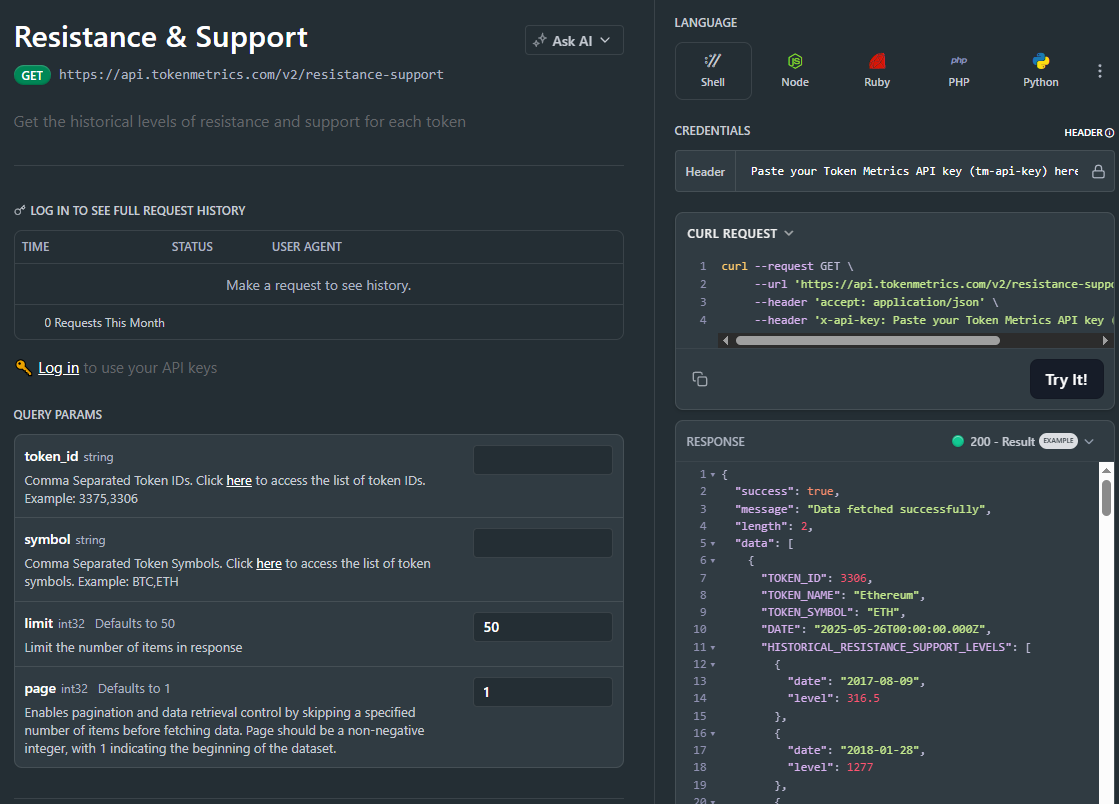
1) What does the Support & Resistance API return?
A JSON payload with arrays of support and resistance levels for a symbol (and optional timeframe), each with a price and strength indicator, plus an update timestamp.
2) How timely are the levels? What are the latency/SLOs?
The endpoint targets predictable latency suitable for dashboards and alerts. Use short-TTL caching for UIs, and queued jobs or webhooks for alerting to smooth traffic.
3) How do I trigger alerts or trades from levels?
Common patterns: alert when price is within X% of a level, touches a level, or breaks beyond with confirmation. Always make downstream actions idempotent and respect rate limits.
4) Can I combine levels with other endpoints?
Yes—pair with /v2/trading-signals for timing, /v2/tm-grade for quality context, and /v2/quantmetrics for risk sizing. This yields a complete decide-plan-execute loop.
5) Which timeframe should I use?
Intraday bots prefer shorter horizons; swing/position dashboards use daily or higher-timeframe levels. Offer a timeframe toggle and cache results per setting.
6) Do you provide SDKs or examples?
Use the REST snippets above (JS/Python). The docs include quickstarts, Postman collections, and templates—start with Run Hello-TM.
7) Pricing, limits, and enterprise SLAs?
Begin free and scale as you grow. See API plans for rate limits and enterprise SLA options.
%201.svg)
%201.svg)
Most traders see price—quants see probabilities. The Quantmetrics API turns raw performance into risk-adjusted stats like Sharpe, Sortino, volatility, drawdown, and CAGR so you can compare tokens objectively and build smarter bots and dashboards. In minutes, you’ll query /v2/quantmetrics, render a clear performance snapshot, and ship a feature that customers trust. Start by grabbing your key at Get API Key, Run Hello-TM to verify your first call, then Clone a Template to go live fast.
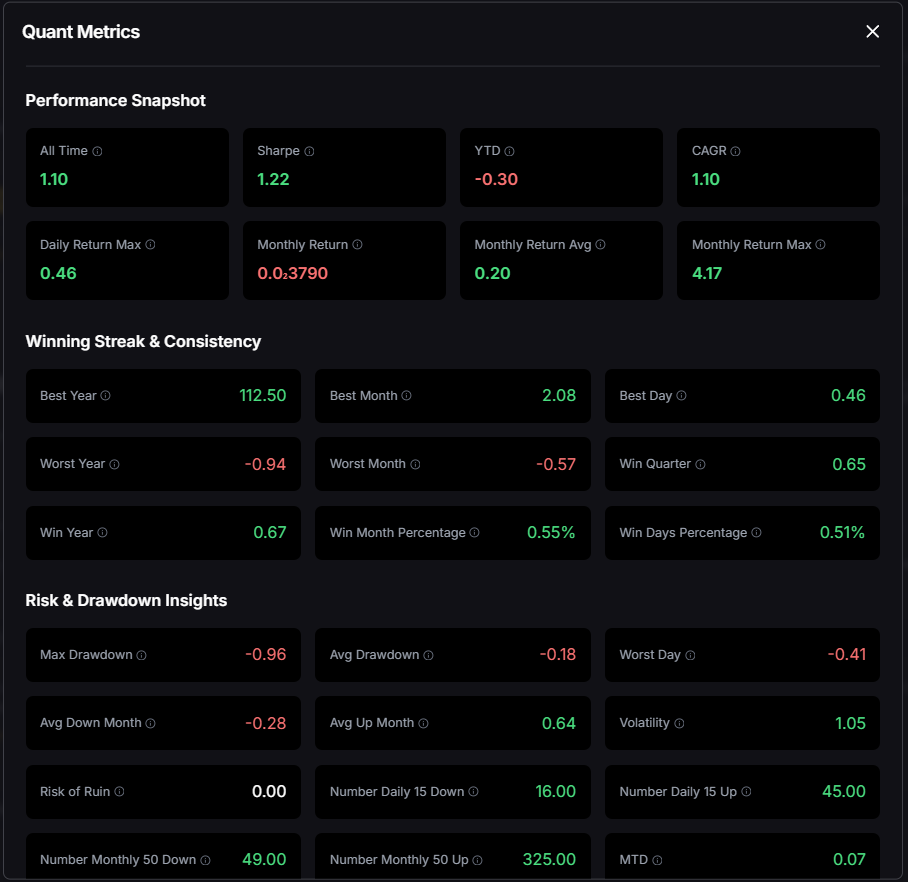
Risk-adjusted truth beats hype. Price alone hides tail risk and whipsaws. Quantmetrics compresses edge, risk, and consistency into metrics that travel across assets and timeframes—so you can rank universes, size positions, and communicate performance like a pro.
Built for dev speed. A clean REST schema, predictable latency, and easy auth mean you can plug Sharpe/Sortino into bots, dashboards, and screeners without maintaining your own analytics pipeline. Pair with caching and batching to serve fast pages at scale.
The Quant Metrics cURL request is located in the top right of the API Reference, allowing you to easily integrate it with your application.
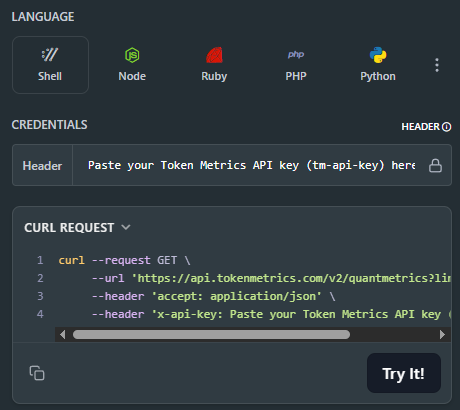
👉 Keep momentum: Get API Key • Run Hello-TM • Clone a Template
Kick off from quickstarts in the docs—fork a dashboard or screener template, plug your key, and deploy in minutes. Validate your environment with Run Hello-TM; when you need more throughput or webhooks, compare API plans.
Quantmetrics computes risk-adjusted performance over a chosen lookback (e.g., 30d, 90d, 1y). You’ll receive a JSON snapshot with core statistics:
Call /v2/quantmetrics?symbol=<ASSET>&window=<LOOKBACK> to fetch the current snapshot. For dashboards spanning many tokens, batch symbols and apply short-TTL caching. If you generate alerts (e.g., “Sharpe crossed 1.5”), run a scheduled job and queue notifications to avoid bursty polling.
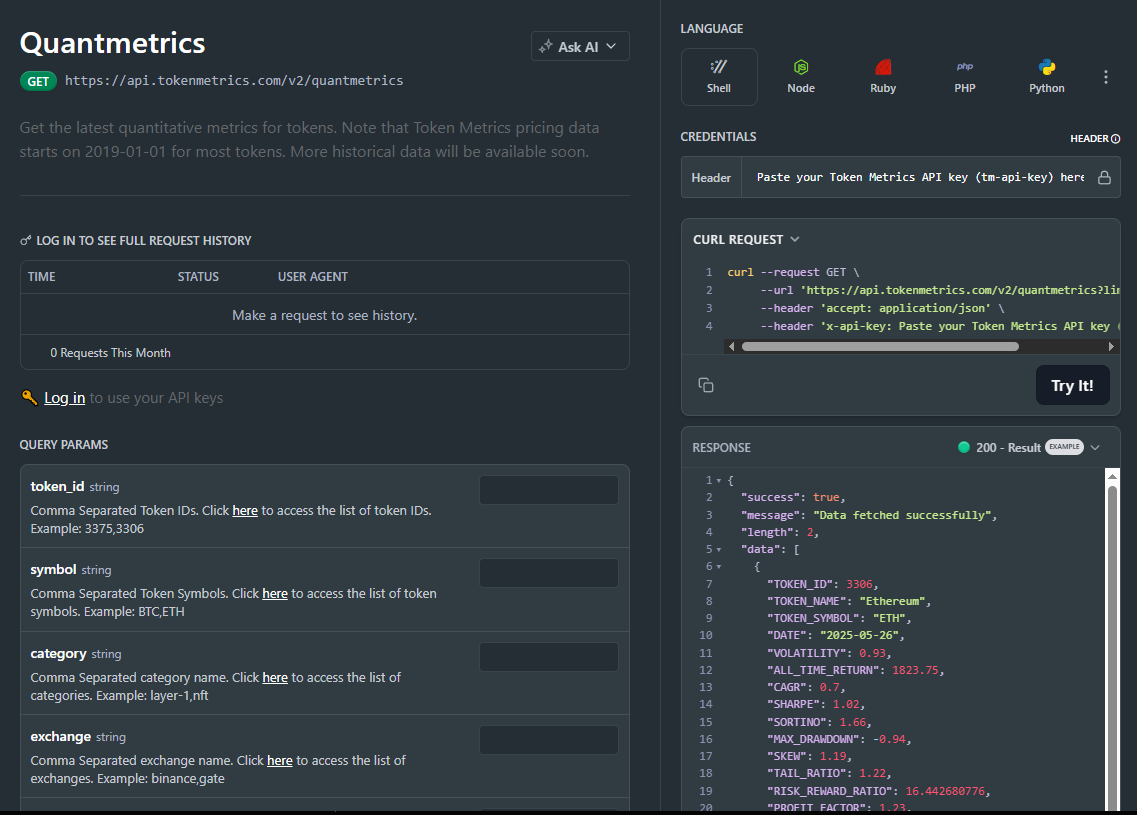
1) What does the Quantmetrics API return?
A JSON snapshot of risk-adjusted metrics (e.g., Sharpe, Sortino, volatility, max drawdown, CAGR) for a symbol and lookback window—ideal for ranking, sizing, and dashboards.
2) How fresh are the stats? What about latency/SLOs?
Responses are engineered for predictable latency. For heavy UI usage, add short-TTL caching and batch requests; for alerts, use scheduled jobs or webhooks where available.
3) Can I use Quantmetrics to size positions in a live bot?
Yes—many quants size inversely to volatility or require Sharpe ≥ X to trade. Always backtest and paper-trade before going live; past results are illustrative, not guarantees.
4) Which lookback window should I choose?
Short windows (30–90d) adapt faster but are noisier; longer windows (6–12m) are steadier but slower to react. Offer users a toggle and cache each window.
5) Do you provide SDKs or examples?
REST is straightforward (JS/Python above). Docs include quickstarts, Postman collections, and templates—start with Run Hello-TM.
6) Polling vs webhooks for quant alerts?
Dashboards usually use cached polling. For threshold alerts (e.g., Sharpe crosses 1.0), run scheduled jobs and queue notifications to keep usage smooth and idempotent.
7) Pricing, limits, and enterprise SLAs?
Begin free and scale up. See API plans for rate limits and enterprise SLA options.
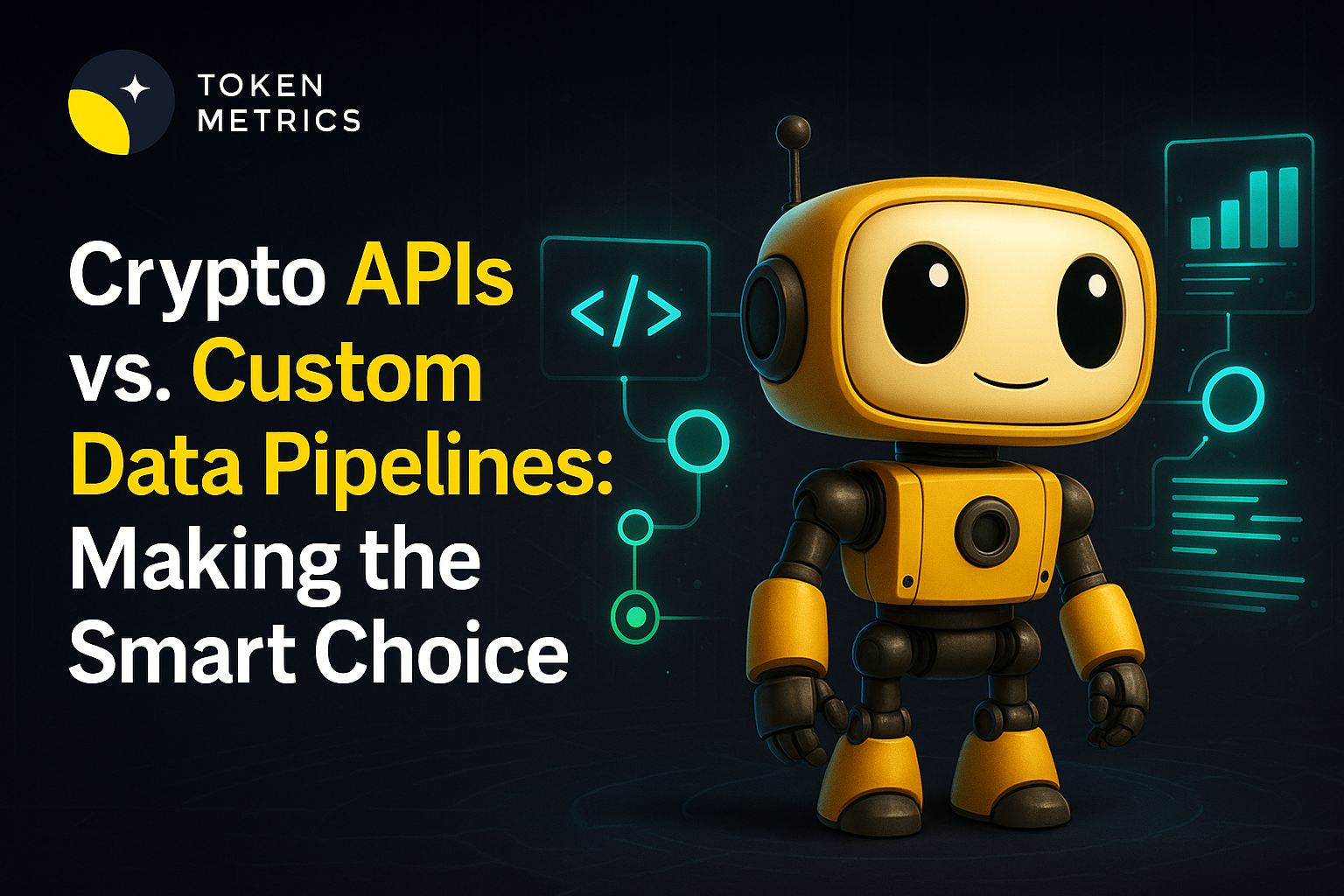
%201.svg)
%201.svg)
The explosive growth in cryptocurrency and blockchain technology has spawned a thriving ecosystem powered by data, automation, and real-time analytics. At the heart of this innovation are APIs—critical tools that connect crypto apps, trading platforms, wallets, and analytics dashboards to the blockchain or market data providers. But not all crypto APIs are created equal. Understanding the differences between REST, WebSocket, and GraphQL APIs can unlock new opportunities for enhanced performance, user experience, and scalability in your crypto projects.
APIs, or Application Programming Interfaces, act as bridges allowing different software systems to communicate with each other. In the context of cryptocurrency, APIs provide access to blockchain data, market price feeds, historical charts, transaction alerts, order book updates, and even smart contract interactions. Crypto APIs make it possible for developers and analysts to:
APIs differ in how they deliver information, their performance characteristics, and their flexibility. The three dominant types—REST, WebSocket, and GraphQL—each have unique strengths and best-fit scenarios.
REST (Representational State Transfer) APIs are among the most widely used in the crypto world. REST APIs rely on standard HTTP methods (like GET, POST, PUT, DELETE) to request or update data. Each endpoint URL represents a specific resource—for example, current price data for BTC/USD or historical trades.
REST remains the backbone of many data feeds, exchange integrations, and base-level blockchain explorers due to its universality and reliability.
For high-speed trading, instant alerts, or live order book monitoring, REST’s limitations become apparent. This is where WebSocket APIs excel. WebSockets enable persistent, bidirectional communication between client and server. Once the connection is established, data flows in real time—no need for repeated requests.
Any serious trading or live data dashboard in the crypto space will rely—at least in part—on WebSocket connections for their core user experience.
GraphQL, developed by Facebook, is a query language and runtime for APIs, and has gained traction in advanced crypto analytics and on-chain data services. Unlike REST, which returns fixed data structures, GraphQL allows clients to specify exactly what information they need in a single request.
GraphQL excels in scenarios demanding detailed, structured blockchain analytics, research dashboards, and customizable front ends that aggregate several data types.
Which API architecture should you use for your crypto development or analytical projects? The answer depends on multiple factors:
Many crypto apps combine these models—using REST for core data, WebSocket for live streams, and GraphQL for specialized research queries. Leading APIs—including Token Metrics—offer a blend of these approaches, allowing developers and analysts to match API features to use case requirements.
Build Smarter Crypto Apps & AI Agents with Token Metrics
Token Metrics provides real-time prices, trading signals, and on-chain insights all from one powerful API. Grab a Free API Key
REST APIs use single, on-demand requests for data, returning results each time a client asks. WebSocket APIs establish a persistent connection, enabling real-time, two-way updates perfect for live price feeds, trading platforms, and instant notifications.
GraphQL APIs are increasingly common for advanced research platforms, analytics dashboards, and projects needing complex, tailor-fit data queries. While REST and WebSocket remain more widespread, GraphQL’s adoption is growing rapidly among leading data providers such as Token Metrics.
Each API type has unique use cases—REST for simplicity and familiarity, WebSocket for real-time needs, and GraphQL for precision and customization. Many modern platforms offer a mix, allowing you to choose the most effective tool per feature.
Yes. Many robust crypto platforms and tools combine REST for standard data queries, WebSocket for live updates, and GraphQL for advanced analytics to provide comprehensive, efficient functionality.
Always secure API keys, use HTTPS, respect rate limits, and implement proper error handling. Choose reputable providers like Token Metrics for consistent data quality and platform security.
This article is for educational and informational purposes only. It does not constitute investment advice, trading recommendations, or offer guarantees of performance. Always conduct independent research and use APIs in accordance with their respective terms and conditions.
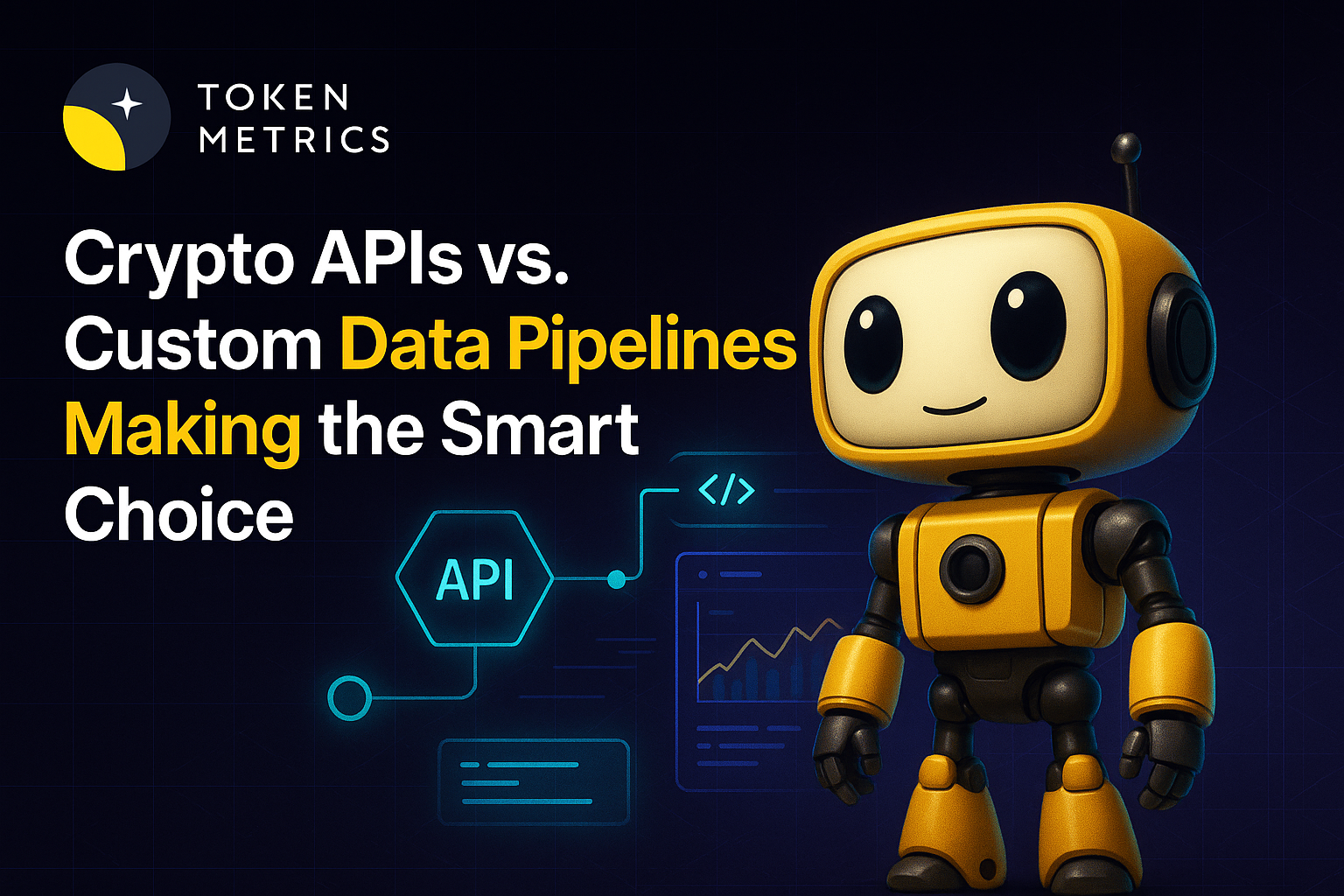
%201.svg)
%201.svg)
The world of crypto moves fast—data updates by the second and new protocols launch every week. Whether you're building trading bots, analytics dashboards, or AI-driven crypto research tools, your core infrastructure decision often comes down to this: should you use a pre-built crypto API or invest the time and resources to build your own data pipeline from scratch?
APIs, or Application Programming Interfaces, serve as gateways to real-time data and services. A crypto API provides standardized access to digital asset information such as price quotes, trading volumes, market histories, technical indicators, on-chain activity, and even AI-driven signals. Instead of scraping dozens of sources or building direct exchange integrations, developers and analysts get reliable, programmable access via a single, unified API. This foundation can power research dashboards, machine learning models, portfolio trackers, web or mobile apps, and more.
Constructing a DIY crypto data pipeline seems appealing for control and customization. However, the journey involves significant obstacles and ongoing effort:
For most users, these risks can outweigh the perceived benefits, especially as data needs become more sophisticated (e.g., real-time, AI-ready, or multi-chain inputs).
Leveraging a trusted crypto API provides significant advantages for both individual analysts and enterprise applications:
By leveraging APIs, developers and researchers capitalize on shared infrastructure, while gaining access to up-to-the-minute datasets crucial for machine learning, backtesting, and AI-driven workflows.
On the surface, building an in-house data solution seems cheaper, especially for technically capable teams. However, true cost calculations must account for:
In contrast, crypto API consumption usually follows a tiered, pay-as-you-grow model. For most projects, this delivers predictable costs versus the hidden, often escalating expenses of DIY approaches.
Many of today’s most innovative crypto tools—from algorithmic trading bots to predictive dashboards—rely on AI and big data analytics. These tools thrive on high-frequency, accurate, and broad market datasets. Building the data foundation in-house often diverts attention and resources from model design or product features.
API-first solutions enable seamless data ingestion for AI, supporting:
In the high-speed world of crypto, this agility and data quality often determine the difference between a useful tool and one that falls behind market realities.
Build Smarter Crypto Apps & AI Agents with Token Metrics
Token Metrics provides real-time prices, trading signals, and on-chain insights all from one powerful API. Grab a Free API Key
Crypto APIs can offer price quotes, historical data, order book snapshots, trading volumes, blockchain transactions, address activity, technical indicators, social mentions, and even AI-generated research signals—all packaged for easy retrieval and analysis.
Reputable API providers implement robust security measures, including end-to-end encryption, access controls, and continuous monitoring. Always research a provider’s security policies and consider limiting API permissions as a best practice.
Most advanced APIs provide real-time or near-real-time updates, typically every few seconds for price data. Some also offer streaming endpoints for continuous delivery. Always check the documentation for specific latency and refresh intervals.
Many APIs aggregate data from several exchanges, blockchains, or analytics providers, ensuring more comprehensive coverage and redundancy versus a single direct integration. This can improve data reliability and reduce downtime.
The Token Metrics API delivers a fusion of real-time market data, on-chain analytics, technical indicators, and algorithmic trading signals, all designed for reliability and easy integration by both developers and researchers.
This blog is for informational purposes only and should not be interpreted as financial, investment, or trading advice. The examples and providers mentioned are for educational comparison and analysis.

%201.svg)
%201.svg)
In the fast-moving world of cryptocurrency and blockchain, the foundation for many apps, exchanges, and research platforms is built on one crucial technology: APIs. If you’ve ever wondered how crypto apps access real-time prices or how traders tap into automated strategies, the answer is often a crypto API. But what exactly is a crypto API, how does it work, and why is it so indispensable?
An API, or Application Programming Interface, serves as a bridge allowing two software systems to communicate. In the context of cryptocurrency, a crypto API enables one platform (such as a website, trading bot, or analytical tool) to connect directly to blockchain networks, exchanges, and relevant databases. Developers and businesses use these APIs to access current market data, account information, blockchain analytics, or to execute operations such as placing a trade or transferring funds.
Crypto APIs are not exclusive to developers. Many common crypto services like portfolio trackers, news aggregators, and AI research tools all rely on APIs to source real-time data that users depend on every day. The use of APIs creates a standardized, efficient, and secure method for interacting with complex decentralized networks.
The primary function of a crypto API is to enable seamless and structured requests between a user-facing platform and deeper data sources, such as exchanges or blockchains. Here’s how the process typically unfolds:
Many APIs provide both public endpoints (such as market summaries or blockchain explorer queries) and private endpoints (like trading or wallet balance checks, which require stronger authentication).
The world of crypto APIs is broad, supporting a wide range of needs within the ecosystem. Here’s a breakdown of popular categories and their use cases:
These APIs underpin countless familiar crypto applications, from exchange mobile apps to AI-driven research platforms like Token Metrics.
Under the hood, most crypto APIs are RESTful, meaning they use standard HTTP methods (GET, POST, PUT, DELETE) to simplify requests and responses. However, some advanced use cases—such as streaming price updates or high-frequency trading—leverage WebSockets or gRPC for real-time, low-latency communication.
Security and authentication are paramount. API keys, OAuth authentication, and IP whitelisting help safeguard sensitive user actions and financial data. Good API providers also implement strict rate limits to ensure performance and fairness among users.
Integration often takes place through SDKs (software development kits) in popular languages like Python, JavaScript, or Java—making it easier for teams to embed crypto functionalities within apps, websites, or even AI agents.
The advantages offered by crypto APIs are profound for both developers and end users:
However, there are important considerations to evaluate when choosing or building a crypto API solution:
AI-powered crypto APIs, like those offered by Token Metrics, combine traditional market data with machine learning insights—unlocking deeper research capabilities for analysts, developers, and product teams.
Build Smarter Crypto Apps & AI Agents with Token Metrics
Token Metrics provides real-time prices, trading signals, and on-chain insights all from one powerful API. Grab a Free API Key
A crypto API lets you pull real-time market data, access blockchain analytics, monitor wallet balances, automate trades, aggregate research, and power custom dashboards. Developers and analysts use APIs to save time, improve data accuracy, and unlock advanced features in their applications.
Most crypto APIs offer a sign-up process where you’ll generate a unique API key. Popular providers like Token Metrics offer both free and premium tiers. Always follow the provider’s onboarding and security instructions when integrating with your software projects or research tools.
Reputable crypto APIs use industry-standard security protocols, such as HTTPS, API keys, and sometimes two-factor authentication or IP whitelisting. Users should store API keys securely and only grant the minimum required permissions for each application to minimize risk.
The best crypto API depends on your project’s needs. Consider factors such as supported exchanges, data refresh rates, reliability, available endpoints, support, and, when needed, AI or analytics features. Comparing providers based on usage requirements is recommended before integrating them into critical applications.
Most crypto APIs are open to developers, startups, and even individual hobbyists. However, some may restrict certain features or require KYC/AML processes for private account actions (such as trading or withdrawals). Always review the provider’s documentation and terms of service.
This content is for informational and educational purposes only. It does not constitute investment advice, offer, or solicitation. Users should exercise caution and conduct independent research before using any API or crypto tool. No endorsement of any specific API or product is implied. Token Metrics is not responsible for third-party API usage or integration outcomes.

%201.svg)
%201.svg)
In an era defined by rapid technological change and evolving cybersecurity threats, maintaining secure and resilient APIs is paramount. Key rotation, the periodic replacement of API credentials, is critical for keeping sensitive systems safe from unauthorized access. However, the challenge lies in updating or replacing API keys without causing disruptions or downtime for your users. How can you design a robust API key rotation strategy that’s both seamless and secure? In this article, we’ll dive deep into practical, real-world approaches for implementing key rotation in your API infrastructures with zero downtime, arming you with the know-how to fortify your applications while upholding uninterrupted service.
API keys are the digital credentials that regulate access to your platform’s endpoints. Over time, these keys can become vulnerable through accidental leaks, code exposure, or insider threats. Regular key rotation limits the lifespan of compromised credentials, minimizing potential attack windows and meeting the compliance demands of standards like SOC 2, HIPAA, and GDPR.
Key rotation can be straightforward for offline systems—but for APIs serving millions of daily requests or integrated into numerous clients, even brief downtime is unacceptable. A sophisticated rotation strategy is essential for:
Rotating keys while maintaining seamless API service is not trivial. Key challenges include:
Ignorance of these pitfalls can result in service downtime, frustrated users, and loss of trust—especially in the high-stakes world of crypto and financial APIs.
Best-in-class API architectures leverage systematic, automation-friendly methods for rotating keys. Here’s a step-by-step overview of how zero-downtime key rotation can be achieved:
This phased approach can be managed via API gateways, secrets managers (like AWS Secrets Manager or HashiCorp Vault), or custom automation pipelines. Automation is crucial for both security and operational scale.
Manual key rotation is error-prone and does not scale. Leading organizations use dedicated tools and APIs for secrets management, automating every phase of the lifecycle:
In the context of crypto APIs, rapid incident response is critical. Automated rotation empowers developers to replace at-risk credentials within minutes, eliminating the manual delays that adversaries can exploit.
Security and uptime are non-negotiable for APIs powering DeFi, exchanges, trading bots, or wallets. Effective rotation design patterns include:
By baking these patterns into your crypto API platform, you not only protect against security risks but also drive developer adoption through reliability and clarity.
Build Smarter Crypto Apps & AI Agents with Token Metrics
Token Metrics provides real-time prices, trading signals, and on-chain insights all from one powerful API. Grab a Free API Key
API key rotation is the process of periodically replacing digital credentials that control access to API endpoints. It is essential for limiting the risk window if a key is exposed and is a fundamental component of secure development and compliance programs.
By allowing both old and new keys to remain active during a transition period, clients can seamlessly migrate to the new key without interruption of service. Downtime only occurs when a key is disabled before all clients have switched over.
Yes. Modern API platforms often integrate with secrets management tools and automation scripts that generate, distribute, and retire keys according to policy—minimizing manual touchpoints and human error.
Continuous monitoring ensures that all clients are migrating as expected and alerts administrators to potential misconfigurations or unauthorized access attempts, enabling swift remediation before issues escalate into downtime.
Absolutely. Solutions like API gateways, cloud-native secrets managers (AWS, GCP, Azure), and specialized crypto API providers like Token Metrics make painless, automated key rotation achievable even at scale.
This article is for general informational purposes only and does not constitute investment, legal, or security advice. Always perform your own due diligence and consult with qualified professionals before implementing any security solution.

%201.svg)
%201.svg)
As the backbone of modern digital communication, APIs are a prime target for cyber threats—especially in crypto, DeFi, and AI-powered applications. One of the most pernicious attacks? The replay attack, in which valid data transmissions are maliciously or fraudulently repeated. For API providers and developers, preventing replay attacks isn’t an option—it's an absolute necessity for robust security.
A replay attack occurs when a malicious actor intercepts a valid data packet and then retransmits it to trick a system into performing unauthorized operations. In API contexts, attackers may reuse valid requests (often containing authentication details) to perform duplicate transactions or gain unauthorized access. Because the replayed request was originally valid, servers without adequate safeguards may not detect the threat.
Robust replay attack prevention begins with understanding core technical methods. The following are widely accepted best practices—often used together for comprehensive protection.
Leading crypto APIs, such as those used for trading, price feeds, or on-chain analytics, deploy multiple techniques in tandem. Here’s an analytical walkthrough of practical implementation:
Importantly, the combination of these techniques not only prevents replay attacks but also helps authenticate requests and ensure integrity—critical for the high-value operations typical in crypto environments.
Developers and security architects must employ a layered defense. Consider adopting the following practical steps:
By following these best practices, API providers can significantly reduce the risk of replay attacks—even in the fast-paced, high-stakes environment of crypto and AI-powered platforms.
Modern API infrastructure benefits from AI-driven monitoring tools that can detect and flag anomalies—such as repeated requests, abnormal traffic spikes, or suspicious timestamp patterns—suggesting a potential replay attack in progress. By integrating machine learning with traditional security controls, application teams can spot sophisticated threats that might slip past static rules, ensuring a more resilient API ecosystem.
Build Smarter Crypto Apps & AI Agents with Token Metrics
Token Metrics provides real-time prices, trading signals, and on-chain insights all from one powerful API. Grab a Free API Key
A replay attack involves resending valid data to trick an API, while a man-in-the-middle attack intercepts and can alter communication between two parties. Both can be used in tandem, but replay attacks specifically exploit a system’s inability to detect previously valid requests being repeated.
Nonces ensure each API request is unique. If an attacker tries to repeat a request using the same nonce, the server recognizes the duplicate and rejects it, preventing unauthorized operations.
TLS/HTTPS encrypt communications but do not inherently prevent replay attacks. Replay prevention requires application-level controls like nonces or timestamps, as encrypted packets can still be captured and resent if no additional safeguards exist.
APIs can log incoming requests’ nonces, timestamps, and signatures. If a duplicate nonce or old timestamp appears, the server detects and blocks the replay. Real-time monitoring and alerting further reduce risks.
Yes. OAuth 2.0, OpenID Connect, and major crypto API specs recommend nonces, timestamp validation, and signatures as standard practices to prevent replay attacks. Following established security frameworks ensures better protection.
This blog is for educational purposes only. It does not constitute investment, legal, or other professional advice. Please conduct your own research or consult experts before implementing security practices in critical systems. Token Metrics does not offer investment services or guarantees of performance.

%201.svg)
%201.svg)
In the fast-moving world of crypto, robust security isn’t just an option—it’s essential. With countless applications powered by APIs exchanging sensitive data, managing cryptographic keys effectively is a foundational pillar for trust and protection. But what exactly does strong key management look like for a crypto API service, and why does it matter so much?
APIs are arteries of modern crypto platforms. They power everything from automated trading to blockchain analytics, moving sensitive data such as user credentials, wallet addresses, and real-time transaction histories. Cryptographic keys serve as the gatekeepers to this data—enabling authentication, encrypting requests and responses, and regulating who can interact with a service.
If keys fall into the wrong hands due to inadequate management, the repercussions are significant: data breaches, unauthorized withdrawals, reputational damage, and regulatory penalties. With rising cyberattacks targeting API endpoints and credentials, the standard for key management in crypto APIs is more rigorous than ever.
Effective key management goes beyond simple storage. The following principles are vital for any crypto API provider or developer:
Every aspect—from onboarding to deprovisioning an API key—should reinforce these pillars.
Securing a crypto API requires a disciplined approach throughout the key’s lifecycle: from its generation and distribution to rotation and retirement. Here’s a best-practices checklist for each stage:
These best practices not only minimize the window of exposure but also simplify legal and regulatory compliance, such as with GDPR or SOC 2 obligations.
API secrets, including API keys, tokens, and passphrases, are prime targets for attackers. Here are proven approaches for secrets management and enforcing secure access control:
Modern cloud-based API management platforms—and frameworks for zero trust security—can streamline these controls and offer centralized monitoring for potential threats.
No security system is infallible. Continuous monitoring and rapid incident response are essential components of key management for crypto APIs:
Adopting a proactive, improvement-focused mindset helps API providers stay resilient as attacker techniques grow more sophisticated.
Build Smarter Crypto Apps & AI Agents with Token Metrics
Token Metrics provides real-time prices, trading signals, and on-chain insights all from one powerful API. Grab a Free API Key
Store keys in dedicated, encrypted vaults or hardware security modules (HSMs). Avoid keeping them in plaintext or hard coding them in application code or configuration files. Limit access via permissions and strong identity controls.
API keys should be rotated regularly (e.g., every 3–6 months) and immediately if there is any sign of compromise, personnel changes, or as part of a scheduled security protocol. Automation can streamline this process for large deployments.
Issuing API keys with only the permissions absolutely necessary for a given user or system—such as read-only vs. write access—limits potential damage if a key is compromised. This approach helps reduce risk exposure and aligns with zero trust models.
Yes. Proper key management practices, such as audit trails, incident response, and robust access controls, are essential components for demonstrating compliance with data protection and integrity standards like GDPR, SOC 2, or ISO 27001.
If an API key is exposed, it should be revoked or rotated immediately. Monitor system logs for unauthorized activity, conduct a root cause analysis to determine how the key was compromised, and update protocols to prevent recurrence.
This content is for educational and informational purposes only and should not be interpreted as legal, security, or investment advice. Always consult relevant professionals when implementing crypto security protocols or designing API services.

%201.svg)
%201.svg)
Securing REST API endpoints has become a fundamental concern for developers, especially as sensitive data and critical operations traverse the web. Choosing the right authentication process is vital, and one approach—HMAC (Hash-Based Message Authentication Code)—provides a robust mechanism to ensure secure and tamper-proof communications. But how exactly do you implement HMAC authentication for a REST API endpoint in practice?
HMAC, or Hash-Based Message Authentication Code, is a cryptographic technique that combines a secret key with a message (such as an HTTP request) and then hashes the combination using a secure hash algorithm (like SHA-256). The output hash, called the HMAC signature, is sent along with the API request. On the server side, the same process is repeated to confirm the authenticity and integrity of the request.
This approach protects against request tampering and eavesdropping because only someone with the shared secret key can generate a valid HMAC signature. Unlike basic authentication, which sends credentials with every request, HMAC signatures help defend APIs against replay attacks and man-in-the-middle threats. Additionally, as requested data is included in the signature, any changes during transit will invalidate the signature and trigger security alerts.
REST APIs are widely adopted due to their scalability, simplicity, and statelessness. However, such characteristics make them attractive targets for unauthorized actors. The benefits of using HMAC authentication for REST APIs include:
Financial institutions, crypto APIs, and enterprise SaaS solutions often favor HMAC as a standard defense mechanism for their public endpoints.
Below is a practical workflow to implement HMAC authentication on your REST API endpoint:
An example Authorization header might look like:
Authorization: HMAC apiKey="abc123", signature="d41d8cd98f00b204e9800998ecf8427e", timestamp="1660000000", nonce="fGh8Kl"
Always use time-based mechanisms and nonces to prevent replay. For REST APIs built in Python, Node.js, or Java, popular libraries are available to generate and validate HMAC signatures. Ensure secure storage of all secrets and keys—never hard-code them in source files or share them over email.
Even well-designed authentication processes can be vulnerable if not properly managed. To maximize HMAC's security benefits, follow these best practices:
Furthermore, document the required signature format and header structure for your API consumers to minimize implementation errors.
HMAC authentication is standard in the world of cryptocurrency APIs, where secure and rapid access to on-chain data and market signals is paramount. Leading blockchain data providers, crypto trading platforms, and analytic tools incorporate some variant of HMAC to manage authentication and authorization.
For developers building trading bots, portfolio trackers, or AI-driven analysis platforms, HMAC-protected REST endpoints are both flexible and secure. They allow granular control of permissions and can support high-frequency interactions without the heavy computational load of asymmetric encryption systems.
As the crypto ecosystem evolves, API authentication standards must adapt. Devs should look for providers and platforms—like Token Metrics—that offer transparent, HMAC-secured endpoints and clear implementation guidelines.
Build Smarter Crypto Apps & AI Agents with Token Metrics
Token Metrics provides real-time prices, trading signals, and on-chain insights all from one powerful API. Grab a Free API Key
The most common algorithms are HMAC-SHA-256 and HMAC-SHA-512, both providing strong security. Avoid using outdated algorithms like MD5 or SHA-1 due to known vulnerabilities. HMAC's flexibility allows other hash functions, but always prioritize well-supported, secure industry standards.
API secrets are typically generated and securely shared out-of-band (e.g., within a secure dashboard or encrypted email during onboarding). On the client, store secrets in environment variables or encrypted secrets managers; on the server, keep secrets in secure databases and never log them.
HMAC and OAuth/JWT are different approaches. HMAC is simpler, faster, and well-suited for service-to-service API authentication. OAuth and JWT, meanwhile, support more sophisticated user-based access or delegated authorization. The best choice depends on your use case and security goals.
HMAC is excellent for ensuring integrity and authenticity, but is not a complete solution against all attacks. Use it in combination with HTTPS, strict input validation, throttle policies, and regular security reviews. Comprehensive threat protection requires defense in depth.
Test both client and server components by intentionally altering requests to ensure invalid signatures are rejected. Use available unit tests, API mocking tools, and logging to confirm signatures are computed and validated as expected. Rotate secrets during testing to check for proper handling.
This content is for informational and educational purposes only. It does not constitute security advice or endorse any provider. Implementation details may vary by project and threat model. Always consult with professional security experts to ensure compliance and best practices.

%201.svg)
%201.svg)
In the rapidly evolving world of cryptocurrencies and blockchain development, security is a top concern—especially when building or integrating with crypto APIs. Encryption forms the backbone of secure data exchange, but the landscape includes more than one approach. Understanding the differences between symmetric and asymmetric encryption, and how each fits into the architecture of a secure crypto API, is fundamental for developers and technical decision-makers. In this article, we'll break down these encryption models, explore their uses within a crypto API, and illustrate how secure apps and services leverage them to safeguard digital assets and sensitive data.
Symmetric encryption is one of the oldest and most widely used cryptographic techniques. At its core, symmetric encryption uses a single, secret key to both encrypt (encode) and decrypt (decode) data. Popular algorithms include Advanced Encryption Standard (AES), Data Encryption Standard (DES), and Triple DES (3DES).
Within crypto APIs, symmetric encryption is often used for encrypting traffic between trusted systems or storing data securely on disk.
Asymmetric encryption, also known as public-key cryptography, solves some of the key distribution problems faced by symmetric encryption. It employs a pair of mathematically related keys: a public key (which can be freely distributed) and a private key (which must be kept secure).
Asymmetric encryption underpins digital signatures, public key infrastructure (PKI), and secure client authentication mechanisms found in most modern crypto APIs.
Both symmetric and asymmetric encryption play vital roles in data security, but each comes with its trade-offs. Here’s a breakdown:
Crypto APIs often combine both methods in a model called hybrid encryption, capitalizing on the strengths of each approach.
In the context of crypto APIs—whether for wallet integration, on-chain analytics, or exchange connectivity—security is not just about encrypting transmission but also about robust authentication and authorization.
This layered approach is considered a best practice for maximizing performance and security in crypto API design.
Developers and architects integrating or building crypto APIs can follow these data-backed practices:
By combining these strategies and leveraging strong encryption, API providers can reduce risk and deliver more secure crypto solutions.
Build Smarter Crypto Apps & AI Agents with Token Metrics
Token Metrics provides real-time prices, trading signals, and on-chain insights all from one powerful API. Grab a Free API Key
The primary drawback is key management: securely distributing and storing the same key among multiple parties can be challenging. If a key is leaked, all previously encrypted data may be exposed.
Asymmetric encryption allows one party to authenticate itself by proving knowledge of a private key without directly sharing that key, reducing the risk of credential theft during communication.
Hybrid encryption uses asymmetric algorithms for secure key exchange and authentication, then switches to symmetric encryption to protect high-speed or large-volume API traffic efficiently.
No. While encryption is essential, APIs must also enforce secure authentication, authorization, rate limiting, input validation, and regular security audits to guard against non-cryptographic attacks.
Developers can use tools like SSL Labs, cryptography libraries supporting key rotation and auditing, and AI-based monitoring within platforms like Token Metrics to monitor crypto ecosystem security risks.
This article is for educational and informational purposes only. It does not constitute investment advice, legal advice, or an endorsement of any protocol, technology, or platform. Always consult security professionals when implementing or handling cryptographic systems.
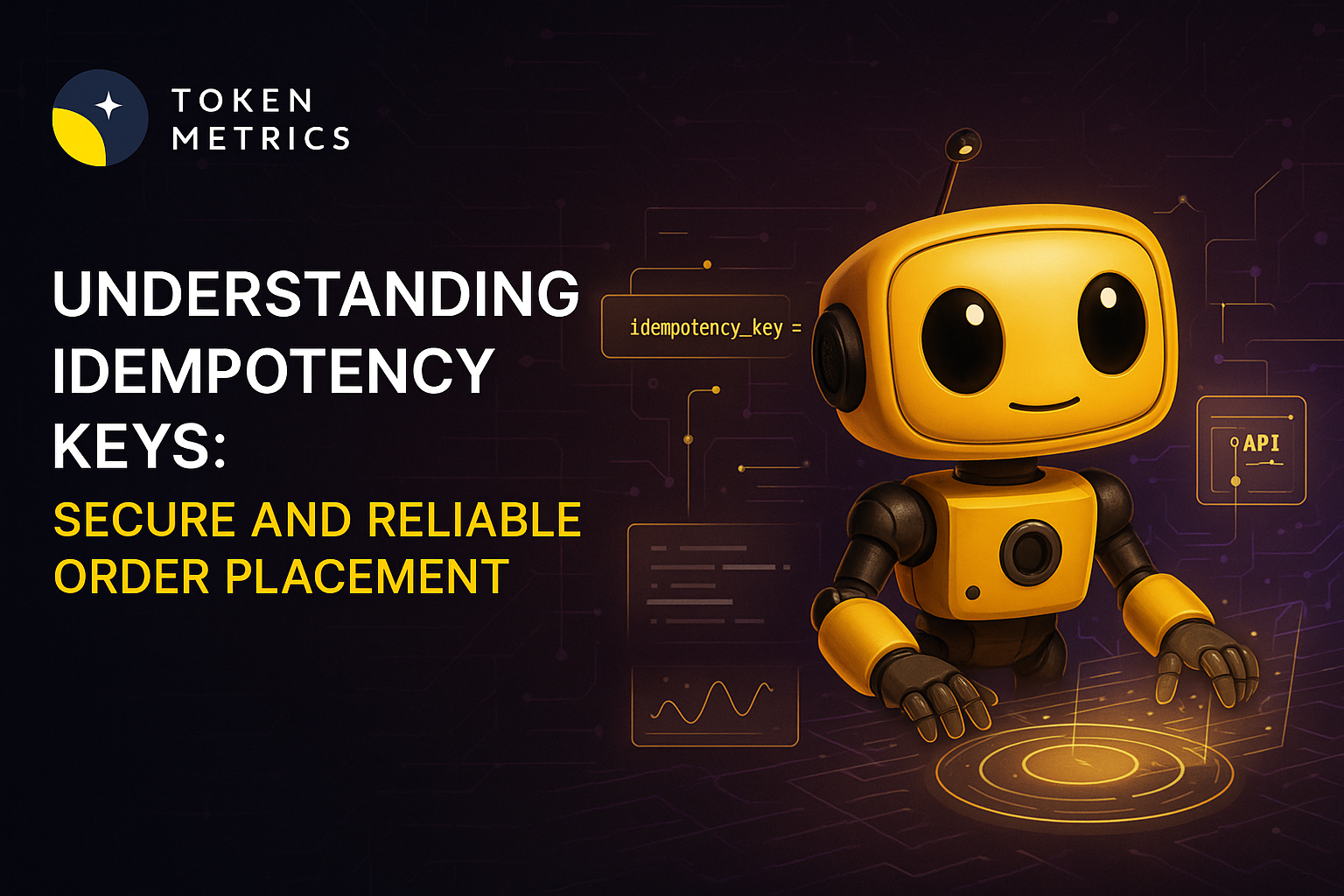
%201.svg)
%201.svg)
In the fast-paced world of crypto trading and financial transactions, ensuring every order is executed exactly once—even when things go wrong—is crucial. Imagine you’re placing a trade but your app crashes or the network glitches. How do you guarantee that your trade is not executed twice by accident? The answer lies in a powerful concept: the idempotency key. Let’s explore what idempotency keys are, why they matter for order placement, and how you can implement them for safer and smarter transactions.
An idempotency key is a unique value generated by the client (such as a web or mobile app) to identify a specific API request. Its primary purpose is to guarantee that a particular operation—like placing a trade order—will only be executed once, even if the request is accidentally submitted multiple times due to network retries, page refreshes, or user error.
The term "idempotent" comes from mathematics and computer science, meaning an operation can be repeated any number of times without changing the result beyond the initial application. In the context of APIs and order placement, an idempotency key helps systems recognize repeated requests and avoid processing them as duplicates.
Let’s consider why idempotency is crucial in placing orders, especially in financial and trading applications:
Such reliability is especially important as trading becomes increasingly automated and more users interact with exchanges and APIs simultaneously.
The typical workflow for using an idempotency key looks like this:
Many leading crypto APIs, including those provided by major exchanges, support idempotency for precisely this reason. The flow ensures that if network issues, user actions, or any other glitches cause the order submission process to be repeated, only one actual trade is created and processed.
Successful and safe use of idempotency keys requires the following best practices within your trading application or order management system:
By following these shared practices, developers and organizations can shield users from costly mistakes and make order processing both robust and predictable.
Consider a trader using an automated crypto bot to submit limit orders to an exchange API. The bot transmits an order, but midway through, the network drops and the bot retries the submission. If the bot includes the same idempotency key on each attempt, only one order is created—even if the server receives two or more requests. This saves both the trader and the market from redundant or distorted trading actions.
This same principle applies to manual trading: if you hit "refresh" after submitting a trade due to uncertainty or a missed confirmation, idempotency keys guarantee that your assets are not exposed to the risk of repeated, unintended purchases or sales.
Major financial institutions and crypto exchanges have widely adopted idempotency key systems. It’s not just technical hygiene—it’s a frontline defense for trust in digital markets.
Build Smarter Crypto Apps & AI Agents with Token Metrics
Token Metrics provides real-time prices, trading signals, and on-chain insights all from one powerful API. Grab a Free API Key
If you do not include an idempotency key, duplicate order submissions may be processed multiple times. This can result in repeated trades, leading to unintended financial outcomes and complicating reconciliation efforts.
Best practice is to generate a random, unique string for each order submission—commonly a UUID. This ensures the key cannot be predicted or duplicated unintentionally between requests.
Idempotency support is common among leading exchanges and institutional-grade APIs, but not universal. Always consult the documentation for your chosen platform and test thoroughly before integrating.
Absolutely. Idempotency keys are useful for various critical actions such as funds transfers, withdrawals, and other transactions where only one occurrence is desired, guarding against unexpected duplicates.
Idempotency keys do not carry sensitive user data—they’re simply unique tokens for tracking API requests. Always use securely generated, random keys to prevent guessing or reuse by malicious actors.
While minimal, the main consideration is ensuring keys are actually unique and properly paired to each transaction. Key storage by the server increases infrastructure complexity slightly, but the benefits far outweigh these small operational concerns in mission-critical applications.
This article is for informational and educational purposes only and does not constitute investment, trading, or financial advice. Always consult relevant professionals and conduct your own research before engaging with APIs or trading platforms. Token Metrics does not provide investment recommendations.


 Create Your Free Account
Create Your Free Account9450 SW Gemini Dr
PMB 59348
Beaverton, Oregon 97008-7105 US
.svg)




.png)
Token Metrics Media LLC is a regular publication of information, analysis, and commentary focused especially on blockchain technology and business, cryptocurrency, blockchain-based tokens, market trends, and trading strategies.
Token Metrics Media LLC does not provide individually tailored investment advice and does not take a subscriber’s or anyone’s personal circumstances into consideration when discussing investments; nor is Token Metrics Advisers LLC registered as an investment adviser or broker-dealer in any jurisdiction.
Information contained herein is not an offer or solicitation to buy, hold, or sell any security. The Token Metrics team has advised and invested in many blockchain companies. A complete list of their advisory roles and current holdings can be viewed here: https://tokenmetrics.com/disclosures.html/
Token Metrics Media LLC relies on information from various sources believed to be reliable, including clients and third parties, but cannot guarantee the accuracy and completeness of that information. Additionally, Token Metrics Media LLC does not provide tax advice, and investors are encouraged to consult with their personal tax advisors.
All investing involves risk, including the possible loss of money you invest, and past performance does not guarantee future performance. Ratings and price predictions are provided for informational and illustrative purposes, and may not reflect actual future performance.


